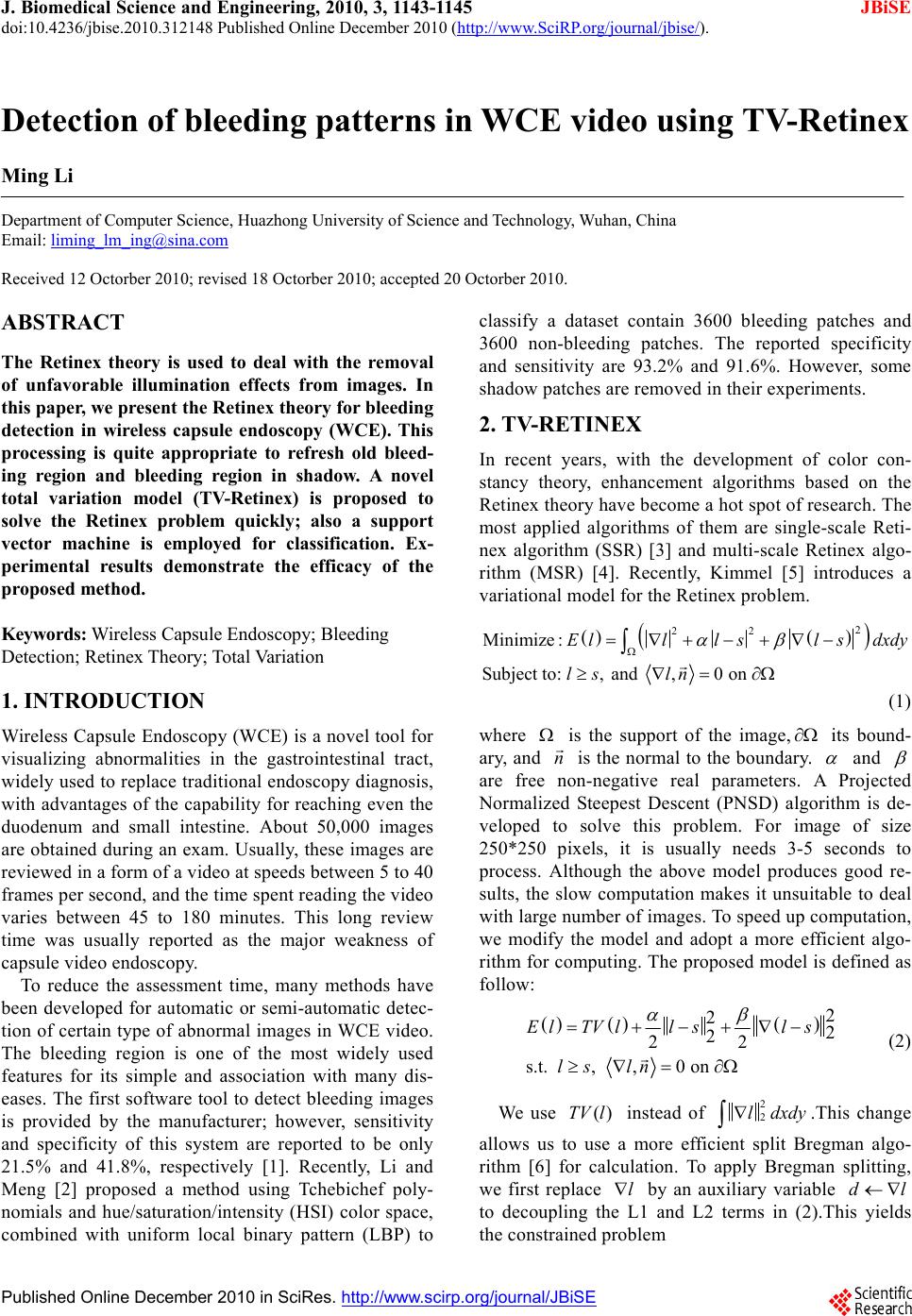
J. Biomedical Science and Engineering, 2010, 3, 1143-1145
doi:10.4236/jbise.2010.312148 Published Online December 2010 (http://www.SciRP.org/journal/jbise/ JBiSE
).
Published Online December 2010 in SciRes. http://www.scirp.org/journal/JBiSE
Detection of bleeding patterns in WCE video using TV-Retinex
Ming Li
Department of Computer Science, Huazhong University of Science and Technology, Wuhan, China
Email: liming_lm_ing@sina.com
Received 12 Octorber 2010; revised 18 Octorber 2010; accepted 20 Octorber 2010.
ABSTRACT
The Retinex theory is used to deal with the removal
of unfavorable illumination effects from images. In
this paper, we present the Retinex theory for bleeding
detection in wireless capsule endoscopy (WCE). This
processing is quite appropriate to refresh old bleed-
ing region and bleeding region in shadow. A novel
total variation model (TV-Retinex) is proposed to
solve the Retinex problem quickly; also a support
vector machine is employed for classification. Ex-
perimental results demonstrate the efficacy of the
proposed method.
Keywords: Wireless Capsule Endoscopy; Bleeding
Detection; Retinex Theory; Total Variation
1. INTRODUCTION
Wireless Capsule Endoscopy (WCE) is a novel tool for
visualizing abnormalities in the gastrointestinal tract,
widely used to replace traditional endoscopy diagnosis,
with advantages of the capability for reaching even the
duodenum and small intestine. About 50,000 images
are obtained during an exam. Usually, these images are
reviewed in a form of a video at sp eeds between 5 to 40
frames per second, and the time spent reading the video
varies between 45 to 180 minutes. This long review
time was usually reported as the major weakness of
capsule video endoscopy.
To reduce the assessment time, many methods have
been developed for automatic or semi-automatic detec-
tion of certain type of abnormal images in WCE video.
The bleeding region is one of the most widely used
features for its simple and association with many dis-
eases. The first software tool to detect bleeding images
is provided by the manufacturer; however, sensitivity
and specificity of this system are reported to be only
21.5% and 41.8%, respectively [1]. Recently, Li and
Meng [2] proposed a method using Tchebichef poly-
nomials and hue/saturation/intensity (HSI) color space,
combined with uniform local binary pattern (LBP) to
classify a dataset contain 3600 bleeding patches and
3600 non-bleeding patches. The reported specificity
and sensitivity are 93.2% and 91.6%. However, some
shadow patches are removed in their experiments.
2. TV-RETINEX
In recent years, with the development of color con-
stancy theory, enhancement algorithms based on the
Retinex theory have become a hot spot of research. The
most applied algorithms of them are single-scale Reti-
nex algorithm (SSR) [3] and multi-scale Retinex algo-
rithm (MSR) [4]. Recently, Kimmel [5] introduces a
varia t ional mo d e l fo r th e R eti nex problem.
2
22
Minimize:
Subject to: , and ,0 on
Elllsl sdxdy
ls ln
(1)
where
is the support of the image, its bound-
ary, and
n
is the normal to the boundary.
and
are free non-negative real parameters. A Projected
Normalized Steepest Descent (PNSD) algorithm is de-
veloped to solve this problem. For image of size
250*250 pixels, it is usually needs 3-5 seconds to
process. Although the above model produces good re-
sults, the slow computation makes it unsuitable to deal
with large number of images. To speed up computation,
we modify the model and adopt a more efficient algo-
rithm for computing. The proposed model is defined as
follow:
2
22
2
22
s.t. , ,0 on
ElTVllsl s
ls ln
(2)
We use instead of
()TV l2
2
ldxdy
.This change
allows us to use a more efficient split Bregman algo-
rithm [6] for calculation. To apply Bregman splitting,
we first replace l
by an auxiliary variable dl
to decoupling the L1 and L2 terms in (2).This yields
the constrained problem